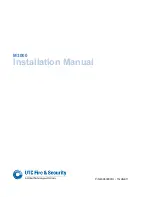
Version 6.6
553
Mediant 3000
User's Manual
42. Automatic Update
42
Automatic Update
Automatic provisioning is useful for large-scale deployment of devices. In some cases, the
devices are shipped to the end customer directly from the manufacturer. In other cases,
they may pass through a staging warehouse. Configuration may occur at the staging
warehouse or at the end-customer premises.
The devices may be pre-configured during the manufacturing process (commonly known
as
private labeling
). Typically, a two-stage configuration process is implemented such that
initial configuration includes only basic configuration, while the final configuration is done
when the device is deployed in a live network.
Automatic provisioning can be used to update the following files:
Software file (
cmp)
Auxiliary files (e.g., Call Progress Tones)
Configuration file (ini)
The Automatic Update mechanism is applied per file, using specific parameters that define
the URLs to the servers where the files are located, and the file names (see Automatic
Update Parameters on page
). These files can be stored on any standard Web, FTP, or
NFS server and can be loaded periodically to the device using HTTP, HTTPS, FTP, or
NFS. This mechanism can be used even for devices that are installed behind NAT and
firewalls.
The Automatic Update mechanism can be triggered by the following:
Upon device startup.
At a user-defined time of day (e.g., 18:00), configured by the
ini
file parameter
AutoUpdatePredefinedTime.
Periodically (e.g., every 60 minutes), configured by the
ini
file parameter
AutoUpdateFrequency.
Upon startup but before the device is operational, if the Secure Startup feature is
enabled (see 'Loading Files Securely (Disabling TFTP)' on page
Upon receipt of a special SIP Notify message (see 'Remotely Triggering Auto Update
using SIP NOTIFY' on page
When implementing Automatic Updates using HTTP/S, the device determines whether the
file on the provisioning server is an updated one as follows:
Configuration file:
The device checks the timestamp according to the HTTP server
response. Cyclical Redundancy Check (CRC) is only checked if the
AUPDCheckIfIniChanged parameter is enabled. The device downloads the
configuration file only if it was modified since the last successful configuration update.
Software file (cmp):
The device first downloads the file and then checks if its version
number is different from the software version file currently stored on the device's flash
memory.
Auxiliary files (e.g., CPT):
These files are updated only once. To update the auxiliary
file again, you must modify the settings of the related parameter that configures its
URL.
42.1 BootP Request and DHCP Discovery upon Device
Initialization
After the device powers up or is physically reset, it broadcasts a BootP request to the
network. If it receives a reply from a BootP server, it changes its network parameters (IP
address, subnet mask and default gateway address) to the values provided. If there is no
reply from a BootP server and if DHCP is enabled (DHCPEnable = 1), the device initiates a
standard DHCP procedure to configure its network parameters.
Summary of Contents for Mediant 3000
Page 2: ......
Page 26: ...User s Manual 26 Document LTRT 89729 Mediant 3000 Reader s Note...
Page 27: ...Part I Getting Started with Initial Connectivity...
Page 28: ......
Page 40: ...User s Manual 40 Document LTRT 89729 Mediant 3000 Reader s Notes...
Page 41: ...Part II Management Tools...
Page 42: ......
Page 44: ...User s Manual 44 Document LTRT 89729 Mediant 3000 Reader s Notes...
Page 80: ...User s Manual 80 Document LTRT 89729 Mediant 3000 Reader s Notes...
Page 98: ...User s Manual 98 Document LTRT 89729 Mediant 3000 Reader s Notes...
Page 103: ...Part III General System Settings...
Page 104: ......
Page 113: ...Part IV General VoIP Configuration...
Page 114: ......
Page 144: ...User s Manual 144 Document LTRT 89729 Mediant 3000 Reader s Notes...
Page 164: ...User s Manual 164 Document LTRT 89729 Mediant 3000 Reader s Notes...
Page 222: ...User s Manual 222 Document LTRT 89729 Mediant 3000 Reader s Notes...
Page 224: ...User s Manual 224 Document LTRT 89729 Mediant 3000 Reader s Notes...
Page 275: ...Part V Gateway and IP to IP Application...
Page 276: ......
Page 278: ...User s Manual 278 Document LTRT 89729 Mediant 3000 Reader s Notes...
Page 399: ...Part VI Session Border Controller Application...
Page 400: ......
Page 402: ...User s Manual 402 Document LTRT 89729 Mediant 3000 Reader s Notes...
Page 464: ...User s Manual 464 Document LTRT 89729 Mediant 3000 Reader s Notes...
Page 465: ...Part VII Stand Alone Survivability Application...
Page 466: ......
Page 474: ...User s Manual 474 Document LTRT 89729 Mediant 3000 Reader s Notes...
Page 494: ...User s Manual 494 Document LTRT 89729 Mediant 3000 Reader s Notes...
Page 497: ...Part VIII IP Media Capabilities...
Page 498: ......
Page 501: ...Part IX High Availability System...
Page 502: ......
Page 515: ...Part X Maintenance...
Page 516: ......
Page 522: ...User s Manual 522 Document LTRT 89729 Mediant 3000 Reader s Notes...
Page 524: ...User s Manual 524 Document LTRT 89729 Mediant 3000 Reader s Notes...
Page 552: ...User s Manual 552 Document LTRT 89729 Mediant 3000 Reader s Notes...
Page 562: ...User s Manual 562 Document LTRT 89729 Mediant 3000 Reader s Notes...
Page 565: ...Part XI Status Performance Monitoring and Reporting...
Page 566: ......
Page 578: ...User s Manual 578 Document LTRT 89729 Mediant 3000 Reader s Notes...
Page 609: ...Part XII Diagnostics...
Page 610: ......
Page 624: ...User s Manual 624 Document LTRT 89729 Mediant 3000 Reader s Notes...
Page 626: ...User s Manual 626 Document LTRT 89729 Mediant 3000 Reader s Notes...
Page 638: ...User s Manual 638 Document LTRT 89729 Mediant 3000 Reader s Notes...
Page 639: ...Part XIII Appendix...
Page 640: ......
Page 864: ...User s Manual 864 Document LTRT 89729 Mediant 3000 Reader s Notes...
Page 871: ...Version 6 6 871 Mediant 3000 User s Manual 55 Selected Technical Specifications Reader s Notes...
















































